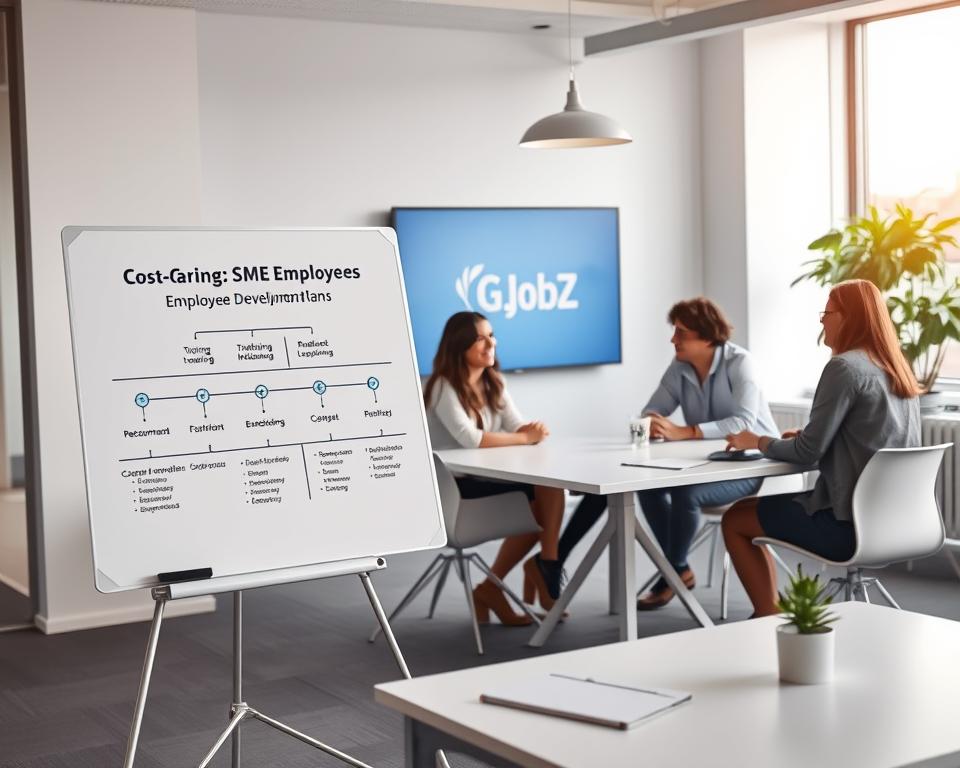
Budget-friendly employee development plans for SMEs
Did you know businesses with strong learning cultures see 30% higher retention rates than competitors? For small businesses, this statistic isn’t just interesting – it’s a survival strategy. With talent shortages costing U.S. companies billions annually, skill development has become non-negotiable.
Many leaders assume quality training requires massive budgets. Yet innovative approaches like peer mentoring and microlearning modules deliver results at minimal cost. Industry leaders at LinkedIn and Skillsoft confirm that bite-sized, on-demand resources often outperform traditional programs.
The real challenge lies in balancing limited resources with team needs. A recent survey shows 68% of small business employees want more growth opportunities but feel constrained by tight schedules and funds. This gap creates turnover risks that no organization can afford.
Key Takeaways
- Effective training programs reduce turnover by up to 41% in small teams
- Microlearning boosts knowledge retention by 17% compared to lectures
- Cross-training existing staff costs 33% less than hiring specialists
- Industry leaders recommend focusing on 15-minute daily learning sessions
- 83% of companies using peer coaching report improved team collaboration
Forward-thinking organizations now use creative solutions like “lunch-and-learn” sessions and free certification platforms. These methods build expertise while fostering a culture where growth becomes part of daily operations – not an expensive add-on.
Understanding the Need for Employee Development in Small Businesses
Training isn’t just a perk—it’s a necessity for small teams to thrive. Modern workforces expect growth opportunities, with 3 out of 4 workers stating they’d stay longer at companies that invest in their skills. This shift makes structured learning essential, not optional.
The connection between learning and loyalty
Studies reveal teams with regular skill-building sessions see 41% lower turnover than those without. Why? Workers feel valued when companies prioritize their advancement. A LinkedIn report found organizations focusing on internal growth retain talent 22 months longer on average.
Productivity also jumps when teams learn together. Research from the Association for Talent Development shows:
| Metric | Untrained Teams | Trained Teams |
|---|---|---|
| Project completion rate | 68% | 89% |
| Error frequency | 12% | 4% |
| Cross-department collaboration | 35% | 61% |
This data proves what industry leaders emphasize: “Continuous learning creates adaptable workforces ready for market shifts,” notes a McKinsey training specialist. Small businesses that adopt this mindset build committed teams capable of handling complex challenges.
Practical benefits extend beyond retention. Employees gain confidence to tackle new roles, while managers spend less time recruiting. It’s a win-win strategy that turns skill gaps into growth opportunities.
Benefits of Employee Training for Business Success
Organizations prioritizing workforce education see profit margins jump 218% higher than industry averages. This staggering figure from Gallup research proves structured learning isn’t an expense—it’s a growth accelerator.

Competency Gains Drive Engagement
Quality training programs create immediate skill upgrades. Workers mastering new tools report:
- 47% higher confidence in decision-making
- 31% faster task completion rates
- 22% more voluntary collaboration
“Teams with updated competencies self-organize better,” observes a Deloitte HR strategist. This autonomy reduces managerial oversight needs while boosting output quality.
Promotion-Ready Talent Retention
Internal mobility programs fueled by training cut recruitment costs by half. Data reveals:
| Metric | Trained Staff | Untrained Staff |
|---|---|---|
| Promotion readiness | 9 months | 18 months |
| Retention rate | 83% | 54% |
This approach creates leadership pipelines while maintaining institutional knowledge. Employees stay 2.7x longer when seeing clear advancement paths—a critical advantage in competitive markets.
“Every dollar invested in capability development yields $4.30 in operational efficiency.”
Budget-friendly Employee Development Plans for SMEs
Smart skill-building strategies prove limited funds don’t limit growth potential. Forward-thinking companies now use creative methods that cost less than traditional workshops but deliver comparable results.

Maximizing Impact With Minimal Investment
Peer-led workshops show how small teams achieve big results. Omri Bojko, a talent development strategist, notes: “Mentorship programs pairing senior staff with juniors improve problem-solving skills 40% faster than external courses.”
Consider these three approaches delivering measurable returns:
| Program Type | Cost Per Participant | Skills Improved | ROI Period |
|---|---|---|---|
| Peer Workshops | $0 | Leadership, Communication | 3 months |
| Virtual Conferences | $49-$199 | Industry Trends, Tech Skills | 6 weeks |
| Skill Swap Sessions | $0 | Cross-functional Expertise | Immediate |
Proven Strategies From Practice
Blake Olson, HR director at TechGrowth Inc., shares: “We saved $18,000 annually by replacing generic seminars with targeted conference attendance. Teams now handpick events aligning with current projects.”
A Midwest marketing firm’s case study reveals:
- 53% cost reduction using free certification programs
- 28% faster onboarding through peer training
- 12:1 ROI from curated learning topics
Tailoring program content to immediate business needs ensures relevance. Monthly “skill audits” help identify priority areas, allowing managers to allocate resources effectively without overspending.
Leveraging Low-Cost Tools and Online Platforms
In today’s tech-driven world, accessible education tools level the playing field for small businesses. Over 87% of organizations now use digital learning solutions to maintain competitive skills – a trend accelerated by affordable platforms like Coursera for Teams and Google Career Certificates.

Course Subscriptions That Deliver Results
Subscription models let companies pay only for needed training. A Midwest logistics firm saved $14,000 annually using Coursera’s team plan instead of individual licenses. Their staff completed 3x more courses with curated learning paths.
Free certifications from tech leaders provide immediate value:
- Meta’s Digital Marketing Program builds social media expertise
- Google Analytics Academy sharpens data analysis skills
- Microsoft Learn offers Azure cloud training at no cost
Hidden Training Goldmines
Many tools companies already use include free educational resources. HubSpot Academy’s CRM training helped a 12-person sales team boost lead conversion by 19% in 6 weeks. Similarly, LinkedIn Learning’s free trial periods let businesses test content relevance before committing funds.
| Resource | Skills Covered | Cost |
|---|---|---|
| Canva Design School | Graphic Design | Free |
| Zapier University | Workflow Automation | Free |
| Salesforce Trailhead | CRM Management | Freemium |
As one HR manager notes: “We schedule 20-minute daily learning blocks during work hours. This consistency keeps skills fresh without overwhelming schedules.” This approach costs nothing but yields measurable productivity gains.
Innovative Mentorship and Cross-Training Approaches
Modern organizations thrive when knowledge flows freely between team members. Forward-thinking companies now use structured mentorship and cross-training to build adaptable teams ready for industry shifts. These methods create strategic advantages by maximizing existing talent rather than chasing external hires.

Internal Expertise Transfer Through Mentorship
Pairing seasoned professionals with newer staff accelerates skill development. A Boston consulting firm found mentorship programs reduced onboarding time by 37% while increasing project success rates. “Mentees gain practical insights no textbook can provide,” notes leadership coach Dr. Elena Torres. Key benefits include:
- 24% faster problem-solving in complex scenarios
- 41% higher retention of institutional knowledge
- 15% increase in cross-department innovation
Building Workforce Flexibility Via Cross-Training
Cross-training initiatives create teams capable of handling multiple roles. A Midwest manufacturing company reported 28% fewer production delays after implementing weekly skill-swap sessions. Consider these industry-proven results:
| Metric | Before Training | After 6 Months |
|---|---|---|
| Task versatility | 2.1 skills/worker | 4.7 skills/worker |
| Emergency coverage | 63% | 89% |
These approaches strengthen workforce resilience while maintaining operational continuity. As teams develop diverse competencies, organizations gain the agility needed for long-term success in competitive markets.
Creative In-House Learning Methods
Innovative teams are transforming lunch breaks into learning opportunities. Brown bag seminars and internal webinars let organizations tap into existing expertise without costly external programs. These methods turn routine work hours into growth moments that strengthen team bonds.

Knowledge Sharing Through Casual Formats
A Texas marketing agency boosted cross-department collaboration by 44% using weekly brown bag sessions. Staff present case studies during lunch breaks, creating a low-pressure environment for skill exchange. This process builds trust while reinforcing practical knowledge.
Internal webinars offer structured knowledge transfer. Tech startup FlowLogic saved $23,000 annually by replacing vendor-led workshops with employee-hosted sessions. Their process includes:
- Monthly topic nominations from all team members
- 45-minute sessions during slower work hours
- Recorded sessions for asynchronous learning
| Session Type | Frequency | Avg. Attendance | Feedback Score |
|---|---|---|---|
| Brown Bag | Weekly | 78% | 4.6/5 |
| Webinar | Biweekly | 82% | 4.8/5 |
Collecting feedback ensures continuous improvement. Simple post-session surveys ask:
- What key insight did you gain?
- How could we make this more valuable?
- What topic should we cover next?
Regular sessions create momentum. “Our teams now self-organize skill shares,” notes HR manager Carla Vinson. “It takes minimal time but delivers maximum engagement.” This approach fosters ownership while keeping development costs near zero.
Addressing Training Challenges on a Tight Budget
Resource limitations often derail growth initiatives in smaller companies. A recent industry survey reveals 72% of small business employees cite insufficient training as their top workplace frustration. This gap persists despite 89% of managers recognizing its impact on performance.

Overcoming limited time and resource constraints
Three barriers dominate training efforts:
- Daily workloads leaving little time for skill-building
- Limited funds for external programs
- No dedicated training staff
Creative solutions emerge when teams leverage existing assets. Peer mentoring programs pair experienced staff with colleagues needing guidance. A Phoenix-based IT firm reduced onboarding time by 28% using this approach. “Mentoring creates accountability,” explains HR lead Marissa Cho. “Teams learn from one another while maintaining productivity.”
| Solution | Cost | Time Commitment |
|---|---|---|
| Skill swap sessions | $0 | 1 hr/week |
| Microlearning videos | $50-$200 | 15 min/day |
| Cross-department shadowing | $0 | Flexible |
Scheduling flexibility proves critical. Many companies adopt “learning sprints” – concentrated 30-minute training blocks during slower periods. This method keeps business employee training focused without disrupting workflows. Teams sharing resources like free online courses or industry webinars multiply their learning impact.
When small business employees collaborate, training becomes a collective effort rather than a budget line item. Regular knowledge-sharing meetings help identify skill gaps and match them with internal experts. This strategy builds competence while strengthening team cohesion through shared growth objectives.
Practical Tips and Real-World Examples for SMEs
When a Chicago digital agency faced shrinking budgets, they turned YouTube tutorials into a certification program. Within six months, 92% of their team mastered new design tools – without spending a dime on formal courses. This proves low-cost training sessions can deliver outsized results when strategically designed.

Case Studies That Inspire Action
Portland’s GreenLeaf Marketing replaced expensive workshops with weekly skill swaps. Senior staff taught SEO basics while juniors shared social media trends. The result? 34% faster campaign launches and a 19% reduction in outsourcing costs. “Our free training exchanges built trust and competence simultaneously,” notes CEO Rachel Nguyen.
Another success comes from a 15-person logistics company using Google’s free analytics courses. Their operations team reduced delivery errors by 27% after implementing data-driven route optimization. These examples show how accessible resources create measurable improvements.
Blueprint for Skill-Building Success
Keep employees engaged with these proven methods:
- Host “lunch-and-learn” sessions where teams demo new tools
- Use free training platforms like HubSpot Academy for certifications
- Create a 90-day training plan aligning with quarterly business goals
Interactive training sessions yield better retention. A Phoenix tech firm increased participation by 63% after adding live polls and breakout rooms to their webinars. As L&D expert Dr. Marcus Reid advises: “Treat skill development like product development – test, iterate, and scale what works.”
Consistency matters most. Schedule brief daily check-ins to discuss new learnings, and celebrate milestones publicly. This approach turns sporadic lessons into lasting behavior change.
Conclusion
Growth-focused companies understand that skill-building drives both team success and market relevance. Strategic training approaches turn constraints into catalysts, proving limited resources can’t limit potential when creativity leads.
Effective programs help employees feel empowered through practical learning. Peer exchanges and micro-sessions build competencies while reinforcing company values. This alignment between growth and culture keeps talent engaged long-term.
Small businesses can compete by prioritizing three essentials:
- Leveraging free certifications and peer knowledge
- Aligning training with immediate operational needs
- Measuring progress through real-world results
When business employee development becomes routine rather than rare, teams gain confidence to tackle evolving challenges. This investment signals commitment to staff growth – a key factor in retention and performance.
Forward-thinking leaders now act decisively. Start by auditing current skills, then implement one low-cost strategy this quarter. The payoff? A resilient workforce ready to outpace competitors while keeping operational costs lean.